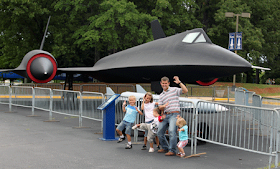
It's significant, especially when you add on the bus tour. The only real downside is the cost to visit this site. There were simulators/rides both inside and outside, and the food at the on-site restaurant was surprisingly good, hot and fresh, although priced as one would expect. We also went into an area where the Environmental Control and Life Support Systems are being developed. We even got to talk to one of the managers. We visited the historic Redstone test site and went inside the Payload Operations Integration Center, where we saw people monitoring the science experiments on board the International Space Station. The bus tour had an extremely knowledgeable guide who has been taking tourists through for years.


VISITING NASA HUNTSVILLE PLUS
You have the amazing history, one of 3 places in the United States you can see a Saturn V rocket, one of a dozen places to see an Apollo command module, plus unique features such as the Apollo 13 Lunar Module trainer, the Apollo 12 crew quarantine trailer and a nicely sized moon rock. I wouldn't want to do this stop without including the bus tour, and they sold out within 1 hour of opening on the Saturday in February when we visited (not exactly peak visiting time!) I paid by credit card over the phone and had zero problem picking up those reserved tickets.Ī lot of places say there is something for everyone, but that's really true, here. I HIGHLY suggest calling the phone number for the center and reserving your bus tour tickets in advance. Our 10-year-old son's favorite part was climbing the rock wall. My husband's favorite part was the afternoon tour through the Marshall Space Flight Center. The CubeSat is designed and developed by NASA Marshall in Huntsville, Alabama, and JPL in Southern California.My favorite part of the day was the guided morning tour through the Davidson Center. NEA Scout is developed under NASA’s Advanced Exploration Systems division. Scientists will use this data to determine what is required to reduce risk, increase effectiveness, and improve the design and operations of robotic and human space exploration, added Castillo-Rogez. “Understanding their properties could help us develop strategies for reducing the potential damage caused in the event of an impact.”

Jim Stott, NEA Scout technology project manager, said. “Despite their size, some of these small asteroids could pose a threat to Earth,” Dr. In the past decade, detections of near-Earth asteroids have steadily risen and are expected to grow, offering expanded opportunities as exploration destinations. Near-Earth asteroids are also important destinations for exploration, in situ resource utilization, and scientific research. “The images gathered by NEA Scout will provide critical information on the asteroid’s physical properties such as orbit, shape, volume, rotation, the dust and debris field surrounding it, plus its surface properties,” said Julie Castillo-Rogez, the mission’s principal science investigator at NASA’s Jet Propulsion Laboratory. The data obtained will help scientists understand a smaller class of asteroids – those measuring less than 100 meters (330 feet) across – that have never been explored by spacecraft. High-resolution imaging is made possible thanks to the low-velocity flyby (less than 100 feet, or 30 meters, per second) enabled by the solar sail. Once it reaches its destination, the spacecraft will use a science-grade camera to capture images of the asteroid – down to less than four inches (10 centimeters) per pixel – which scientists will then study to further our understanding of these small but important solar system neighbors. Sailing on sunlight, NEA Scout will begin an approximate two-year journey to fly by a near-Earth asteroid.

NEA Scout is also a stepping-stone to another recently selected NASA solar sail mission, Solar Cruiser, which will use a sail 16 times larger when it flies in 2025. “This type of propulsion is especially useful for small, lightweight spacecraft that cannot carry large amounts of conventional rocket propellant,” Johnson said. Over time, this constant thrust can accelerate the spacecraft to very high speeds, allowing it to navigate through space and catch up to its target asteroid. Energetic particles of sunlight, called photons, bounce off the solar sail to give it a gentle yet constant push. The large-area sail will generate thrust by reflecting sunlight. The CubeSat will use stainless steel alloy booms to deploy an aluminum-coated plastic film sail – thinner than a human hair and about the size of a racquetball court. “There have been several sail tests in Earth orbit, and we are now ready to show we can use this new type of spacecraft propulsion to go new places and perform important science.” “NEA Scout will be America’s first interplanetary mission using solar sail propulsion,” said Les Johnson, principal technology investigator for the mission at NASA’s Marshall Space Flight Center.


 0 kommentar(er)
0 kommentar(er)
